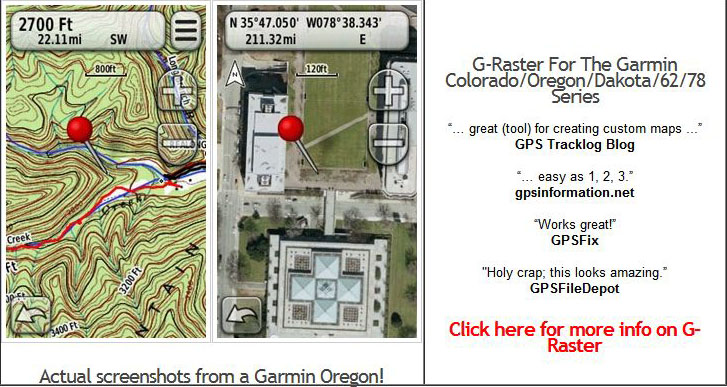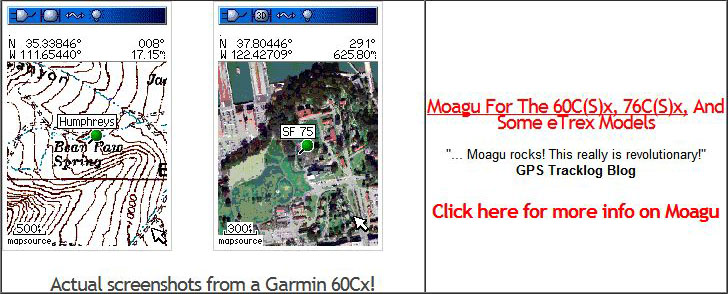Last post, I covered G-Raster, a free program I wrote that converts georeferenced imagery (GeoTiffs, MRSID, BSB, IMG, and graphics with worldfiles) into KMZ overlays compatible with some of Garmin’s more recent handheld GPS models (the Colorado, Oregon, and Dakota series). While G-Raster does a good job by itself on most such imagery, like that found at the USGS Seamless Server, there are a few programs that may be more convenient for obtaining georeferenced raster graphics (topo maps and aerial imagery), and modifying the imagery if necessary.
USAPhotoMaps: I’ve covered this free program before; it downloads USGS topographic maps, black-and-white 1-meter aerial imagery, and urban 0.25-meter color imagery from the Terraserver site. But you can also export JPG copies of the imagery using the Big JPEG function (File => Create a BIG jpeg file), which also exports a worldfile in UTM NAD83 coordinates. G-Raster has built-in support for these Big JPEG files; you only need to select “USAPhotoMaps Big JPEG” as the file type, then select the exported image file (found in the program directory after export). You’ll need the UTM zone as well – get that by choosing UTM coordinates for display (View => Lat/Lon => UTM). The imagery is in JPEG format, and won’t be in quite as high quality as that from the USGS Seamless Server, but should be more than good enough for most uses. As a bonus, you can also create GPX waypoint files directly in USAPhotoMaps using the map imagery; this lets you create both the navigation points and map imagery at the same time.
MicroDEM: I’ve also covered MicroDEM many times on this site. A small subset of its many functions can be helpful in editing/modifying imagery for use in creating Garmin KMZ overlays:
– The maximum pixel size for creating a Garmin KMZ overlay is 100 million pixels; if your image is larger than that, G-Raster will modify it to meet that criteria. But you can get better control over the final results by modifying the image yourself. MicroDEM lets you crop an image, or rescale it to a lower resolution.
– MicroDEM also offers direct access to Terraserver imagery, and can export it in GeoTiff format. While a bit more cumbersome than USAPhotoMaps, the final results are of slightly higher quality, and also offers the capability to choose the pixel resolution for the Terraserver imagery. For example, USAPhotoMaps exports black-and-white aerial imagery in either 1-meter per pixel or 8-meter per pixel resolutions; MicroDEM offers the choice of 1,2,4,8,16,32 and 64 meter per pixel resolution. By trading off resolution, you can cover larger areas in a single KMZ overlay file.
– Finally, MicroDEM can open shapefiles, color them thematically, and export the map as a G-Raster-compatible GeoTiff. While there are tools that can convert shapefiles into Garmin vector maps that display much more quickly than raster maps, this is a far easier approach, and gives you better control over the final appearance of the imagery as viewed on your GPS.


